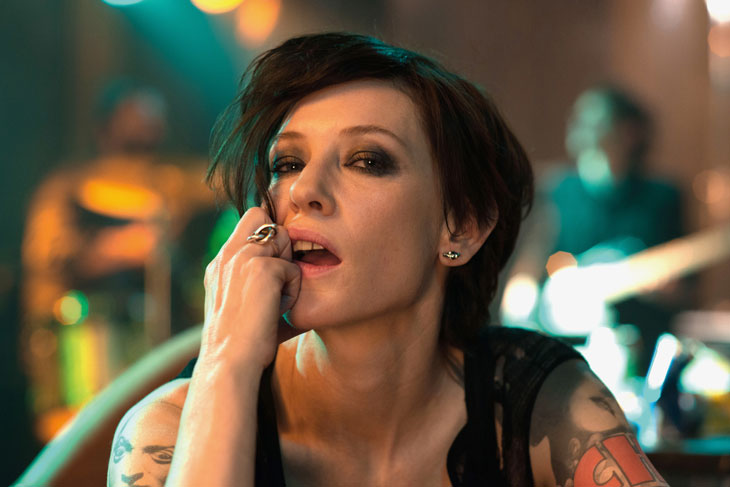‘I am writing a manifesto because I have nothing to say’. The words of preeminent Surrealist, Philippe Soupalt, set a provocative tone as one of the opening lines in Julian Rosefeldt’s new film, Manifesto. His inventive first feature-length production draws on the seminal texts that shaped the identity of artistic movements including Surrealism, Constructivism, and Futurism, to explore the intersections between art, literature, and film. Presented as a series of individual episodes narrated by 13 different characters – all played brilliantly by two-time Oscar winner Cate Blanchett – the film asks what it means to translate the artistic manifesto on screen, and how this may affect the contemporary viewers’ relationship with these texts.
Manifesto by Julian Rosefeldt, part of the BFI London Film Festival 2017
The film serves, in part, as a brief history of the manifesto, beginning with Karl Marx’s Communist tract, which is often regarded as the origin of the form, and culminating with the ideas of contemporary filmmakers including Jim Jarmusch and Werner Herzog. Not all are literary masterpieces, but they are emotionally charged, political, performative works. Rosefeldt himself compared the act of reading of them to theatre. Originally screened as a 13-channel installation, this 95-minute continuous version received its debut at this year’s Sundance Film Festival. It is difficult to determine which format works best, but as the feature film progresses, it certainly highlights interesting ideas about the nature of the manifesto. One striking revelation is how similar the rhetoric is across almost all of the major texts. These span stylistic preferences, political leanings, decades and generations, yet each writer or collective declares their visual practice as the way of the future – from Bruno Taut’s pursuit of ‘everlasting change’ to the John Reed Club’s struggle for a ‘weapon in the battle for a new and superior world’.
Loaded with utopian ideas, these visions of change can seem tragic or even sinister with hindsight. In one episode, the combative words of the Futurists, whose founding manifesto was published in 1909, ring out over rows and rows of screens in a broker’s office. Their imagined future – a picture of youthful, frenetic energy powering the machine age – turned quickly into dystopian reality with the outbreak of war a few years later. The doctrine of Situationism is narrated by a homeless man wandering through desolate rubble; his anarchic cries for freedom from oppressive commercialism echo around decaying remnants of modernity. Even relatively recent texts take an ominous turn in the final scenes as Jim Jarmusch’s Golden Rules of Filmmaking (2002) are drilled into the minds of a class of young children. The effect is that Manifesto simultaneously invites us to reengage with these ideas as though ‘they weren’t just historical art documents’ (as Rosefeldt puts it), while also remembering their historical context.
Manifesto by Julian Rosefeldt, part of the BFI London Film Festival 2017
Rosefeldt’s film comes into its own when word and image unite in ways that not only serve the linguistic power of the texts, but also allow Rosefeldt to indulge in visual flourishes of his own. Aerial shots of urban decay and architectural features morph into abstract motifs as the words of Kazimir Malevich and Alexander Rodchenko are delivered in a monotonous disembodied voice; sometimes the images seem to guide us towards certain interpretations, and at others they let the words speak for themselves. Other scenes make playful nods to the imagery of the original texts, updated to reflect today’s concerns. A conservative matriarch recites Claes Oldenburg’s iconic I am for an art… (1961) to her family as a prayer, highlighting the dogmatic status of art manifestos. (Oldenberg himself insisted that ‘I don’t necessarily believe all those things. But I, at some point, might believe them.’) The distrust of language as championed by Conceptual artists including Sol LeWitt, is reported by a contemporary news reader in the age of ‘fake news’. The ‘new’ vocabulary of Surrealism is spoken by a puppeteer in an aptly uncanny sequence.
Owing mostly to Cate Blanchett’s skilful performance, the film manages to capture some of the energy of these influential texts. It shines a light on the nature of the artistic manifesto; literary documents that can be both poetic and political, with an important performative power. The film collapses the distance between the viewer and the texts, granting them striking immediacy while acknowledging how times have (or haven’t) changed. These manifestos have, over the years, been revered, rejected, or reinterpreted. The biggest reward of the film is the ability to hear their words anew.
Manifesto by Julian Rosefeldt, part of the BFI London Film Festival 2017
‘Manifesto’ screens at the BFI Southbank, London, on 6 October, and at the Picturehouse Central, London, on 8 October, as part of the BFI Film Festival.
